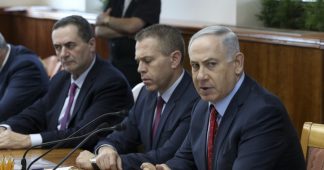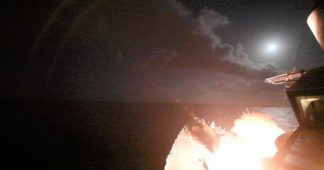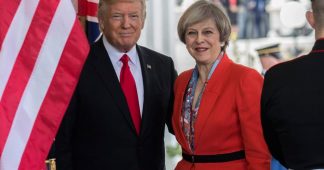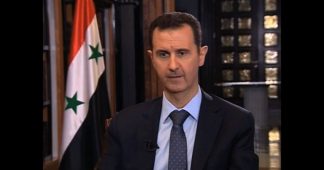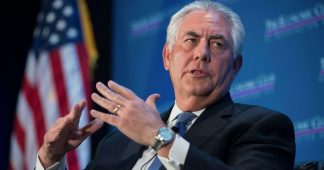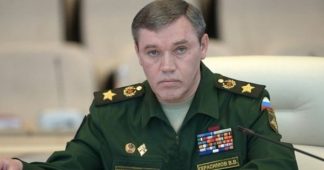Military Strikes on Syria: Critical Considerations
By Michael Eisenstadt
April 10, 2018
Military action should seek to restore deterrence by hitting not just chemical weapons-related targets, but also ground and air units that are key to the Assad regime’s war effort.
In response to the latest reported use of chemical weapons (CW) by Assad regime forces near Damascus on April 7, which reportedly killed dozens of civilians in the town of Douma, President Trump tweeted that there would be a “Big price to pay.” He subsequently told a cabinet meeting on April 9, “We cannot allow atrocities like that. Cannot allow it…Nothing’s off the table.” He then warned that regardless of whether Russia, the Assad regime, or Iran was responsible, the U.S. response would be “very tough,” repeating that everybody involved would “pay a price.”
If the United States opts to act militarily, its policy should be guided by several considerations. First, Washington should seek to divide Bashar al-Assad’s coalition with Iran and Russia. This means eschewing actions that could drive them together at a time when their interests may diverge (e.g., Moscow might be annoyed that Assad overreached by using CW, since such acts could drag the United States back into the war at a time when it seemed to be disengaging). Washington should also eschew actions that increase the potential for escalation; rather, the goal should be to de-escalate the situation by restoring deterrence vis-a-vis the Assad regime.
Specifically, any U.S. strikes should focus on regime assets while avoiding targets with higher risk of Russian casualties. Washington should also support Israel’s ongoing strikes against Iranian targets in Syria (establishing an informal division of labor there), to impose costs on Tehran for its policies. And the administration should continue to reserve the right to take action of its own against Iranian assets in Syria when they threaten U.S. personnel or interests.
Second, this problem will not end with a single set of strikes. Deterrence has a limited shelf life, and Assad will likely continue defying the international community and challenging the CW redline. Additional strikes may be necessary to deter him from doing so.
Third, the main “weapons of mass destruction” in Syria have been barrel bombs, artillery, and small arms. While CW may have killed several thousand, conventional arms have killed more than a hundred thousand civilians. Thus, while U.S. strikes should target CW infrastructure when collateral damage can be minimized, they should focus primarily on the regime’s conventional military capabilities. Focusing solely on CW capabilities would limit the damage to dispensable assets—the United States should also target forces that have been essential to Assad’s victories, namely, ground units such as the 4th Armored Division, Republican Guard, and Tiger Force, along with air units that deliver barrel bombs and CW. This would hinder the regime’s war effort much more than strikes focusing solely on CW capabilities.
This targeting strategy would have the added benefit of affecting the regime’s patrons. Russia and Iran have ensured the sustainability of their expeditionary activities in Syria by offloading risk and burdens on others, particularly Hezbollah and other foreign Shia militias. If U.S. strikes diminish Assad’s key ground and air units, this would increase the load on Russia, Iran, and the latter’s “Shia foreign legion,” raising the costs of their intervention.
To achieve that goal, U.S. forces would need to target major headquarters and destroy key capabilities and the people who enable them. Although Russia and Iran can replace the Assad regime’s equipment, they cannot replace its manpower, and manpower is what it lacks most. Moreover, by hitting the headquarters of the above-named ground units—which are manned by Alawites connected to the regime via family ties—the United States would strike a heavy blow and magnify the deterrent effect compared to hitting less important units or CW infrastructure alone. The administration should also consider striking symbolic targets such as the Presidential Palace on Qasioun Mountain overlooking Damascus, whose destruction could have a significant psychological effect on the regime and the Syrian people.
Fourth, U.S. military actions should be guided by lessons learned in past efforts at deterrence and coercive diplomacy in the Middle East:
- The United States should not set additional redlines unless it is willing to enforce them, and it should be prepared to answer any further attempts to test U.S. limits, since failure to respond would only invite more challenges.
- Because disproportionate responses are prohibited by the Law of Armed Conflict, Washington should respond to Syrian challenges asymmetrically. Thus, it should hit not only the source of the provocation, but also assets that the regime truly values. Striking only disposable assets would enable Assad to sustain his defiance, calibrate risk, and more safely test U.S. limits. Responding asymmetrically would introduce uncertainty into his cost-benefit calculus about future U.S. responses, thereby strengthening the deterrent effect of U.S. strikes.
- The administration should make clear that its strikes will not be a one-off operation by employing constructive ambiguity about the possibility of future strikes. Otherwise, Assad may believe that he can outlast the United States, and the deterrent effect of a strike will be limited.
Finally, Washington should use the threat of a strike to test the potential for multilateral diplomacy. This threat might help drive a wedge between Damascus and Moscow, and perhaps create new opportunities for pressing Syria to eliminate its undeclared CW stockpiles and observe its ceasefires with various rebel forces around the country—though experience does not provide reason for optimism.
* Michael Eisenstadt is the Kahn Fellow and director of the Military and Security Studies Program at The Washington Institute.
Published at http://www.washingtoninstitute.org/policy-analysis/view/military-strikes-on-syria-critical-considerations
